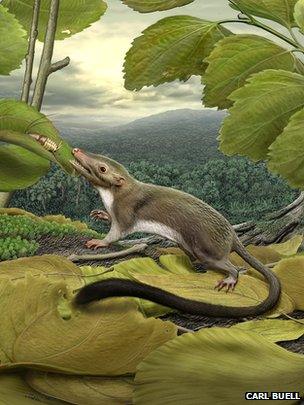Earliest placental mammal ancestor pinpointed
- Published

The ancestral creature probably ate insects, and weighed no more than a few hundred grams
The creature that gave rise to all the placental mammals - a huge group that includes whales, elephants, dogs, bats and us - has at last been pinpointed.
An international effort mapped out thousands of physical traits and genetic clues to trace the lineage.
Their results indicate that all placental mammals arose from a small, furry, insect-eating animal.
A report in Science, external resolves the debate as to when the creature lived; it came about after the demise of dinosaurs.
That had been a hotly debated question over years of research.
Placental mammals - as opposed to the kind that lay eggs, such as the platypus, or carry young in pouches, such as the kangaroo - are an extraordinarily diverse group of animals with more than 5,000 species today. They include examples that fly, swim and run, and range in weight from a couple of grams to hundreds of tonnes.
A wealth of fossil evidence had pointed to the notion that the group, or clade, grew in an "explosion" of species shortly after the dinosaurs' end about 65 million years ago.
But a range of genetic studies that look for fairly regular changes in genetic makeup suggested that the group arose as long as 100 million years ago, with mammals such as early rodents sharing the Earth with the dinosaurs.
'Tree of Life'
Deciphering the very distant past on the basis of fossils and animals that are around today is inherently a subjective business.
"Comparative anatomy" - in which, for example, the forelimbs of a number of fossils are compared to establish which are most closely related - was the entire toolbox for the earliest palaeontologists. The era of genetics ushered in a more incisive tool to compare similarities across species.
But the new work tackles the question of placental mammals in unprecedented detail, taking six years to develop a database of physical and genetic data some 10 times larger than any used previously - and taking a decidedly modern take on it.
"Anatomy and research in palaeontology had a very 19th Century veneer to it - that we would sit in small groups in a lab with a fossil describing it," said lead author of the study Maureen O'Leary of Stony Brook University in New York, US.
"That is a very effective and important part of what we do, but by trying to bring this into the 21st Century and using new software, we were able to really band together as a group of experts and tackle a much larger problem," she told BBC News.
To build the database, the team gathered more than 4,500 details of phenotype - diet, lengths of limbs, shapes of teeth, length of fur if any, and so on - from 86 different species that are around today, and from 40 fossils of extinct animals.
To that they added some 12,000 detailed images and genetic information for all of the current species, putting all the data into what Dr O'Leary called "a supermatrix - essentially like a spreadsheet, filled with observations and images, to create a really rich description of mammals we'd sampled".

The work handles the tricky combination of physical and genetic measurements
That, in essence, allows not just one or a few researchers to log details and make comparisons of, for example, fossil or genetic data; it becomes a problem shared - in this case, among 23 co-authors.
"That really wasn't possible until we developed this software called Morphobank, external. Our experts in China or Brazil or Canada or the US or just across the hall could all be working in one place at the same time," Dr O'Leary said.
By noting which traits have been preserved down the lineage and how they are expressed, the team was able to feed their phenotypic and genetic data into standard software that makes relationship and age estimates - suggesting the ancestral animal lived just 200,000 years after the extinction event that saw the end of the dinosaurs.
It also yields informed guesses as to the traits of the ancestral animal that gave rise to them all, and the team incorporated them into an artist's conception of what it would have looked like.
The result resolves a long-standing debate, but Dr O'Leary said it could also contribute to a new way of tackling such thorny questions.
"I think that it will go a long way toward showing people a way forward for using all the data... both DNA and anatomy. I think that had been an intimidating kind of project because of its scale," Dr O'Leary said.
"Now that we can do that... we are sort of iteratively working and refining the 'Tree of Life' in that way."
- Published25 August 2011